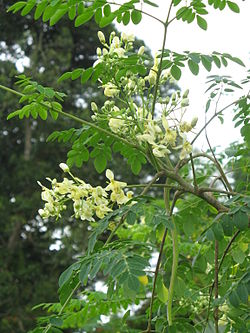Moringa oleifera: Difference between revisions
Created page with '{{SPlantbox |genus=Moringa |species=oleifera |Min ht metric=cm |Temp Metric=°F |jumpin=This is the plant information box - for information on light; water; zones; height; etc. I…' |
No edit summary |
||
| (3 intermediate revisions by the same user not shown) | |||
| Line 1: | Line 1: | ||
{{SPlantbox | {{SPlantbox | ||
|familia=Moringaceae | |||
|genus=Moringa | |genus=Moringa | ||
|species=oleifera | |species=oleifera | ||
| | |common_name=Drumstick tree, Horseradish tree, Ben oil tree | ||
|name_ref=Wikipedia | |||
|habit=tree | |||
|habit_ref=Wikipedia | |||
|Max ht box=10 | |||
|Max ht metric=m | |||
|height_ref=Wikipedia | |||
|lifespan=perennial | |||
|exposure=sun | |||
|water=wet, moist, moderate, dry | |||
|water_ref=Wikipedia | |||
|features=edible, fruit, drought tolerant | |||
|Temp Metric=°F | |Temp Metric=°F | ||
| | |min_zone=9 | ||
|image= | |usda_ref=Wikipedia | ||
|image_width= | |max_zone=12 | ||
|image=Moringa oleifera sg.jpg | |||
|image_width=180 | |||
}} | }} | ||
Moringa oleifera is the most widely cultivated species of the genus Moringa, which is the only genus in the family Moringaceae. It is an exceptionally nutritious vegetable tree with a variety of potential uses. The tree itself is rather slender, with drooping branches that grow to approximately 10 m in height. In cultivation, it is often cut back annually to 1 meter or less and allowed to regrow so that pods and leaves remain within arm's reach. | |||
{{Inc| | {{Inc| | ||
Moringa oleifera, Lam. (M. pterygosperma, Gaertn.). Horse-Radish Tree. Ben | Moringa oleifera, Lam. (M. pterygosperma, Gaertn.). Horse-Radish Tree. Ben. Small tree (reaching 25 ft.), with soft wood and corky bark, the young parts pubescent: lvs. mostly 3-pinnate, ¾-2 ft. long, all parts stalked: fls. whitish, stalked, fragrant, 1 in. across: pod often 1½ ft. long, 9-ribbed, bearing 3- angled, winged seeds. India, but now spontaneous in parts of the W. Indies.—The horse-radish tree is so named from the pungent taste of the root, which is sometimes eaten. The young fr. is also edible. The seeds (called bennuts) yield an oil which is more or less used in the arts. The tree is sometimes cult.in the extreme S. U. S.; it has been grown in S. Calif, for many years. | ||
}} | }} | ||
==Cultivation== | ==Cultivation== | ||
As with all plants, optimum cultivation depends on producing the right environment for the plant to thrive. Malunggáy is a sun and heat-loving plant, and thus does not tolerate freeze or frost. | |||
===Propagation=== | ===Propagation=== | ||
In the Philippines, malunggáy is propagated by planting 1–2 m long limb cuttings, preferably from June to August. The plant starts bearing pods 6–8 months after planting, but regular bearing commences after the second year, continuing for several years. It can also be propagated by seeds, which are planted an inch below the surface and can be germinated year-round in well-draining soil. | |||
===Pests and diseases=== | ===Pests and diseases=== | ||
| Line 41: | Line 57: | ||
==External links== | ==External links== | ||
*{{wplink}} | *{{wplink}} | ||
*http://latimesblogs.latimes.com/home_blog/2011/11/moringa.html | |||
{{stub}} | {{stub}} | ||
__NOTOC__ | __NOTOC__ | ||
Latest revision as of 11:54, 1 December 2011
| Moringa oleifera subsp. var. | Drumstick tree, Horseradish tree, Ben oil tree | |||||||||||||||||||||||||||||||||||||||||||||||||||||||
|---|---|---|---|---|---|---|---|---|---|---|---|---|---|---|---|---|---|---|---|---|---|---|---|---|---|---|---|---|---|---|---|---|---|---|---|---|---|---|---|---|---|---|---|---|---|---|---|---|---|---|---|---|---|---|---|---|

|
|
| ||||||||||||||||||||||||||||||||||||||||||||||||||||||
| ||||||||||||||||||||||||||||||||||||||||||||||||||||||||
Moringa oleifera is the most widely cultivated species of the genus Moringa, which is the only genus in the family Moringaceae. It is an exceptionally nutritious vegetable tree with a variety of potential uses. The tree itself is rather slender, with drooping branches that grow to approximately 10 m in height. In cultivation, it is often cut back annually to 1 meter or less and allowed to regrow so that pods and leaves remain within arm's reach.
| Standard Cyclopedia of Horticulture |
|---|
|
Moringa oleifera, Lam. (M. pterygosperma, Gaertn.). Horse-Radish Tree. Ben. Small tree (reaching 25 ft.), with soft wood and corky bark, the young parts pubescent: lvs. mostly 3-pinnate, ¾-2 ft. long, all parts stalked: fls. whitish, stalked, fragrant, 1 in. across: pod often 1½ ft. long, 9-ribbed, bearing 3- angled, winged seeds. India, but now spontaneous in parts of the W. Indies.—The horse-radish tree is so named from the pungent taste of the root, which is sometimes eaten. The young fr. is also edible. The seeds (called bennuts) yield an oil which is more or less used in the arts. The tree is sometimes cult.in the extreme S. U. S.; it has been grown in S. Calif, for many years.
|
Cultivation
As with all plants, optimum cultivation depends on producing the right environment for the plant to thrive. Malunggáy is a sun and heat-loving plant, and thus does not tolerate freeze or frost.
Propagation
In the Philippines, malunggáy is propagated by planting 1–2 m long limb cuttings, preferably from June to August. The plant starts bearing pods 6–8 months after planting, but regular bearing commences after the second year, continuing for several years. It can also be propagated by seeds, which are planted an inch below the surface and can be germinated year-round in well-draining soil.
Pests and diseases
Varieties
Gallery
-
photo 1
-
photo 2
-
photo 3
References
- Standard Cyclopedia of Horticulture, by L. H. Bailey, MacMillan Co., 1963
External links
- w:Moringa oleifera. Some of the material on this page may be from Wikipedia, under the Creative Commons license.
- Moringa oleifera QR Code (Size 50, 100, 200, 500)
- http://latimesblogs.latimes.com/home_blog/2011/11/moringa.html
